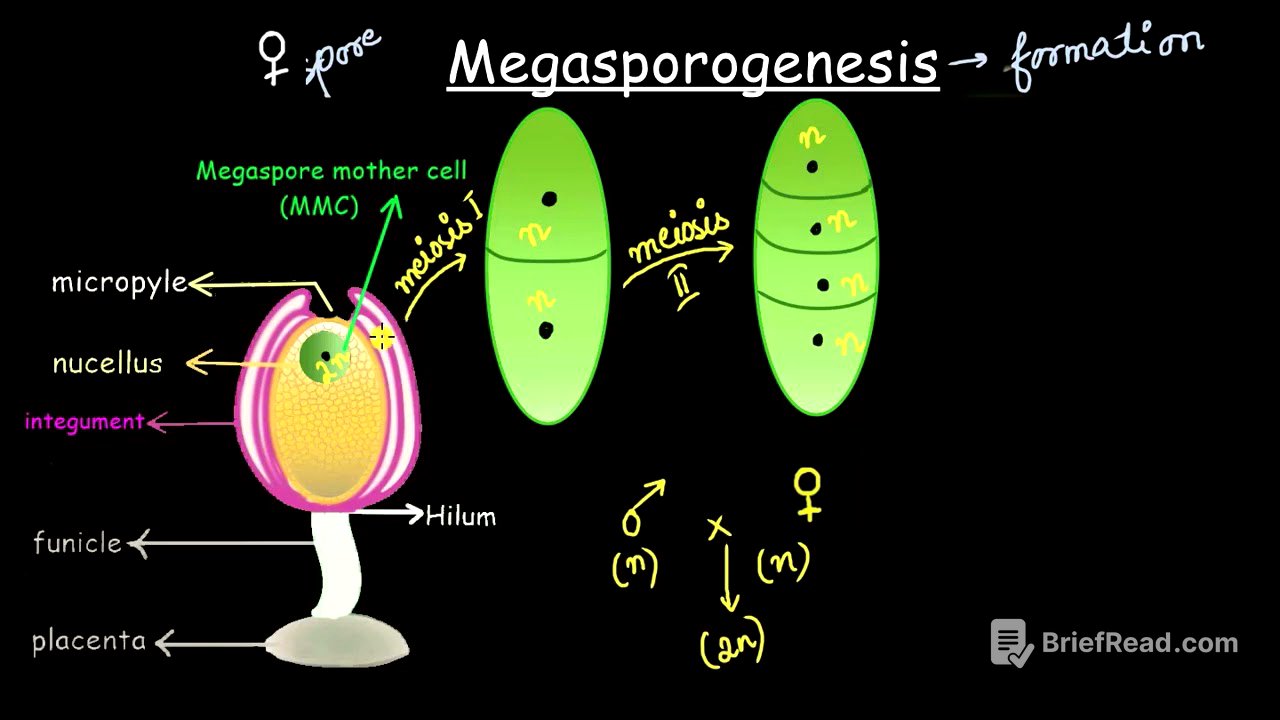TLDR;
This video explains megasporogenesis, the process of megaspore (female spore) formation inside the ovule. It details how a megaspore mother cell (MMC) develops from the hypodermal region of the ovule, undergoes meiosis to produce four haploid megaspores, and ultimately results in one functional megaspore after the other three degenerate. The video also compares megasporogenesis with microsporogenesis (male spore formation), highlighting key differences in the number and functionality of spores produced.
- Megasporogenesis is the process of female spore formation inside the ovule.
- A megaspore mother cell (MMC) undergoes meiosis to produce four megaspores.
- Only one megaspore remains functional, while the other three degenerate.
- Megasporogenesis is monosporic, as only one spore develops into the embryo sac.
- Male spores are more in number because they have to travel to stigma and many get destroyed in the process.
Introduction to Megasporogenesis [0:00]
The video introduces the topic of megasporogenesis, which is the process of how megaspores, or female spores, are formed inside the ovule (megasporangium). It builds upon the previous discussion of the female reproductive part of a flower and the structure of the ovule. The focus is on detailing the development of the megaspore within the ovule.
The Megaspore Mother Cell (MMC) [1:03]
Inside the ovule, a mass of cells called the nucellus is present. One cell from the hypodermal region near the micropyle area of the nucellus grows in size to become the megaspore mother cell (MMC). The hypodermal region is the cell layer underneath the epidermal layer of the nucellus. This MMC accumulates cytoplasm and will eventually undergo cell division to produce megaspores. The surrounding cells provide nourishment to the growing MMC.
Meiosis in the MMC [3:32]
The megaspore mother cell (MMC) undergoes meiosis, a reduction division, to produce megaspores. Meiosis I results in two cells, each with half the number of chromosomes (n) compared to the MMC (2n). Meiosis II, similar to mitosis, then occurs, resulting in four haploid cells (n). Meiosis occurs during sporogenesis and gametogenesis to reduce the chromosome number by half, ensuring that the fusion of male and female gametes results in a diploid organism with the same number of chromosomes as the parent plant.
Degeneration of Megaspores and Functional Megaspore [6:01]
Out of the four megaspores produced, three degenerate, sacrificing their nourishment to support the development of the remaining one. This remaining megaspore becomes the functional megaspore, which is haploid. Because only one spore ultimately gives rise to the embryo sac, the process is called monosporic development.
Comparison with Microsporogenesis [7:00]
In microsporogenesis, multiple cells within the tapetum layer are capable of forming microspores, and all of these cells become microspore mother cells, simultaneously undergoing meiosis to produce a large number of functional microspores. In contrast, during megasporogenesis, only one cell becomes the megaspore mother cell. The number of male spores is higher because they have to travel to the stigma, and many are destroyed in the process. Megaspores, however, are safely located within the ovule and do not face the same risks.
Question and Answers [9:50]
If a megaspore mother cell has 20 chromosomes, it will produce one functional megaspore. The functional megaspore will have half the number of chromosomes as the megaspore mother cell, which is 10 chromosomes.









